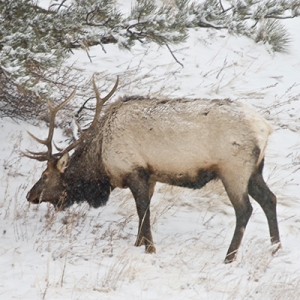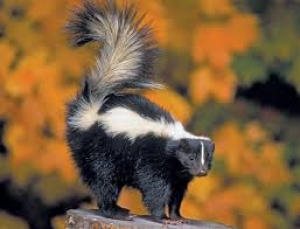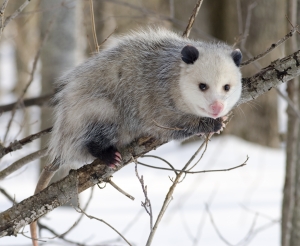
Native Animal of the Month: Elk
Few things illustrate a more beautiful image of winter in Wisconsin than a cervid in the snow. The hooved creatures conjure some type of nostalgia in our minds: a docile doe grazing for food beneath powdery snow, a statuesque bull moose wading through an icy pond, or a heavily antlered elk standing in silhouette as its warm breath escapes in wispy trails. Surely you can’t refute the holiday spirit swirling through your mind when you envision such a scene?
Native Animal of the Month: Eastern American Toad
Many folk tales, urban legends, and myths have led people to believe just plain inaccurate things about some of our wild creatures. Dragonflies were believed to be the Devil’s helpers by sewing naughty children’s eyes shut while they slept. Bats were believed to get tangled in people’s hair in the dark because of misconceived poor eyesight. And, ravens were thought to be premonitions of death. I’ve heard countless critter myths throughout the years, but one creature in particular continues to surprise me with its maligned status: cue the American Toad.
Native Animal: Striped Skunk (Mephitis mephitis)
A potent odor in Three Bridges Park recently led us to a dead skunk lying next to the Menomonee River. It rested, amazingly intact, on a sewerage outflow pipe lightly covered in snow. Whether he was the victim of hypothermia, winter starvation or a ravenous hawk remained a mystery, but whatever the skunk’s demise, it was clear that two weeks after he had perished, his scent still lingered.
Native Animal of the Month: Eastern Screech Owl
Last fall at Riverside Park, the research and community science department was hosting the Wisconsin DNR’s bat biologists for an evening of bat mist netting, when a gregarious little screech owl paid us a visit. As DNR biologist Paul White held the large group of participants enraptured with a live bat, a persistent whinny in the distance distracted those of us at the back of the group.
Native Animal: Opossum (Didelphis virginiana)
When I think of the opossum, I think of a scrappy little character; tough, resilient, clever, and tenacious. In fact, one of my first memories of the opossum demonstrates its impressive adaptability. When tree hollows and brush piles provided inadequate shelter, the resourceful opossum sought shelter elsewhere - she would sneak in under our house's raised foundation and hunker down next to the hot water pipes beneath the bathrooms. There, she would build a comfortable bed of dry grass and stay till spring. And sometimes, when my family would take a shower or bath, you could even hear the scratching of little opossum paws against the water pipes, presumably acknowledging the relief provided by the warm plumbing.
Native Animal of the Month: Beaver (Castor canadensis) Part 2
By now you have probably heard about the Riverside Park Beaver. He’s been chewing down Milwaukee River Greenway trees since the summer of 2014, has been featured on local news segments, has been written about in social media and blog articles, and even became the star of our recent Earth Month grant-matching campaign. But, how much do you really know about this busy beaver? You might be surprised to learn that this species is much more complex than one might think.
Native Animal of the Month: Beaver (Castor canadensis)
I have a confession. A part of me enjoyed when the Riverside Park beaver was a secret. I liked sneaking through the park examining tree trunks along the river for signs of beaver chewing. I enjoyed watching the progress of the chew on the large cottonwood that first revealed signs of the beaver. I enjoyed sharing the location of the tree with nature-loving volunteers and I entertained myself by photographing two of those volunteers with the last name "Beaver" kneeling next to the tree pretending to gnaw at the bark.
Native Animal of the Month: Common Snapping Turtle
I once found a frozen snapping turtle in a river. He lay motionless under a sheet of ice still looking very much alive. His long tail and thick neck were unmistakable through the blurry ice. The image served as a reminder of the difficulty of being a wild animal living in a Wisconsin winter: an unfortunate casualty of harsh sub-degree temperatures, unable to find a nourishing morsel when most needed. A short-time after encountering the turtle, I investigated how turtles survive the winter. I was surprised to read that turtles can live motionless under the ice by going into a type of hibernation. Alas, the turtle I had encountered earlier in the winter hadn't been dead, but had been peacefully passing the winter in the unfrozen water just beneath the ice! A slowed heart rate, a drop in body temperature, a winter of no breaths; what a risky and remarkable winter adaptation this creature experiences!
Native Animal of the Month: Northern Shrike
Imagine a fierce predatory bird that deftly picks off mammals and smaller birds. She spends hours of her day in the cold Canadian taiga, battling food scarcity and searching for sustenance. Once her unsuspecting prey is spotted, she swoops mid-air, stunning the prey with a sharp blow to the head and impales it swiftly on a piece of barbed wire. She may do this several times a day, caching her food in preparation for hard times to come. Such a clever and dominant bird, never letting her diminutive size stop her. For even a songbird the size of a robin can prove a formidable warrior.
Native Animal of the Month: Gray Wolf
Of all the creatures in the animal kingdom, perhaps none has inspired so much folklore and legend as the wolf. From the wolf gods of Norse mythology to the recent pairing of werewolves and vampires in popular culture, stories featuring this misunderstood mammal abound. Separate fact from fiction, however, and you’ll discover a fascinating species with an important place in the ecosystem.
Copyright © 2023 The Urban Ecology Center












